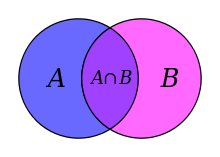Transitive set
In set theory, a set A is transitive, if and only if
- whenever x ∈ A, and y ∈ x, then y ∈ A, or, equivalently,
- whenever x ∈ A, and x is not an urelement, then x is a subset of A.
Similarly, a class M is transitive if every element of M is a subset of M.
Examples
Using the definition of ordinal numbers suggested by John von Neumann, ordinal numbers are defined as hereditarily transitive sets: an ordinal number is a transitive set whose members are also transitive (and thus ordinals).
Any of the stages Vα and Lα leading to the construction of the von Neumann universe V and Gödel's constructible universe L are transitive sets. The universes L and V themselves are transitive classes.
Properties
A set X is transitive if and only if  , where
, where  is the union of all elements of X that are sets,
is the union of all elements of X that are sets,  . If X is transitive, then
. If X is transitive, then  is transitive. If X and Y are transitive, then X∪Y∪{X,Y} is transitive. In general, if X is a class all of whose elements are transitive sets, then
is transitive. If X and Y are transitive, then X∪Y∪{X,Y} is transitive. In general, if X is a class all of whose elements are transitive sets, then  is transitive.
is transitive.
A set X which does not contain urelements is transitive if and only if it is a subset of its own power set,  The power set of a transitive set without urelements is transitive.
The power set of a transitive set without urelements is transitive.
Transitive closure
The transitive closure of a set X is the smallest (with respect to inclusion) transitive set which contains X. Suppose one is given a set X, then the transitive closure of X is
Note that this is the set of all of the objects related to X by the transitive closure of the membership relation.
Transitive models of set theory
Transitive classes are often used for construction of interpretations of set theory in itself, usually called inner models. The reason is that properties defined by bounded formulas are absolute for transitive classes.
A transitive set (or class) that is a model of a formal system of set theory is called a transitive model of the system. Transitivity is an important factor in determining the absoluteness of formulas.
In the superstructure approach to non-standard analysis, the non-standard universes satisfy strong transitivity.[1]
See also
References
- ↑ Goldblatt (1998) p.161
- Ciesielski, Krzysztof (1997), Set theory for the working mathematician, London Mathematical Society Student Texts 39, Cambridge: Cambridge University Press, ISBN 0-521-59441-3, Zbl 0938.03067
- Goldblatt, Robert (1998), Lectures on the hyperreals. An introduction to nonstandard analysis, Graduate Texts in Mathematics 188, New York, NY: Springer-Verlag, ISBN 0-387-98464-X, Zbl 0911.03032
- Jech, Thomas (2008) [originally published in 1973], The Axiom of Choice, Dover Publications, ISBN 0-486-46624-8, Zbl 0259.02051
External links
- Weisstein, Eric W., "Transitive", MathWorld.
- Weisstein, Eric W., "Transitive Closure", MathWorld.
- Weisstein, Eric W., "Transitive Reduction", MathWorld.
| ||||||||||||||||||||||||||||||||

